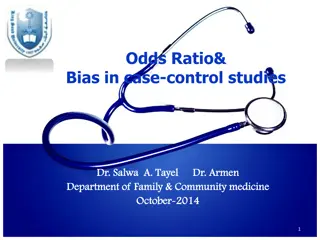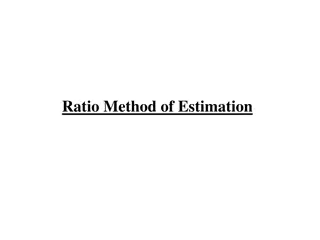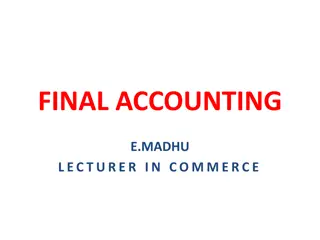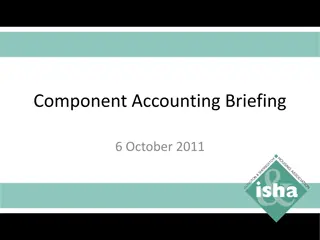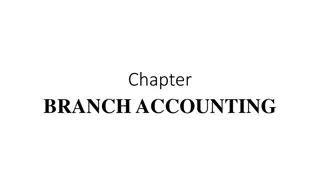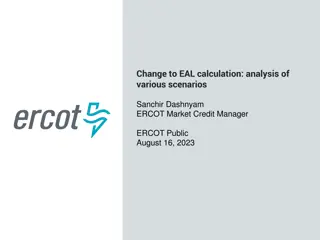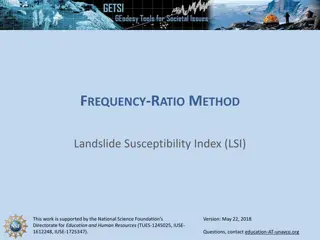Financial Statement Analysis and Ratio Calculation in Accounting
Explore the essential concepts of financial statement analysis, including ratio calculation, liquidity measures, operating efficiency, profitability assessment, and solvency analysis. Understand how to compare financial statements within a company, against industry averages, and with competitors. Discover reliable sources for financial statement information and learn to calculate key ratios for performance evaluation.
- Financial statement analysis
- Ratio calculation
- Liquidity measures
- Operating efficiency
- Comparative analysis
Download Presentation

Please find below an Image/Link to download the presentation.
The content on the website is provided AS IS for your information and personal use only. It may not be sold, licensed, or shared on other websites without obtaining consent from the author. Download presentation by click this link. If you encounter any issues during the download, it is possible that the publisher has removed the file from their server.
E N D
Presentation Transcript
Financial Accounting Module 15: Financial Statement Analysis
Module Learning Outcomes Compare financial statements and analyze performance 15.1: Describe how financial statements are used to analyze a business 15.2: Calculate ratios that indicate a company's ability to pay short-term debt 15.3: Calculate ratios that indicate a company's operating efficiency 15.4: Calculate ratios that analyze a company s earnings performance 15.5: Calculate ratios that analyze a company s long-term debt-paying ability 15.6: Compare financial statements - intercompany and intracompany
Learning Outcomes: Objectives of Financial Statement Analysis 15.1: Describe how financial statements are used to analyze a business 15.1.1: Define financial statement analysis 15.1.2: Identify common sources of information for financial statement analysis
Financial Statement Analysis Defined Ratio Analysis: examine the relationship among financial statement data. Liquidity measures assess the short-term ability of the company to pay obligations and to meet unexpected cash needs. Operating efficiency measures assess how efficiently a firm is paying its bills, collecting cash from customers, and turning inventory into sales. Profitability measures assess the income or operating success of a company for a given period of time. Solvency measures assess the ability of the company to survive over a long period of time. Comparative Analysis: compare different ratios or measures Intracompany comparisons covering two years for the same company. Industry-average comparisons based on average ratios for particular industries. Intercompany comparisons based on comparisons with a competitor in the same industry.
Sources of Information For publicly traded companies, your most reliable source of information for financial statement analysis will be the Form 10-K filed with the SEC. These can be found on each company s website. Additionally, there are some services, like Morningstar, that have computed some of the ratios and compiled additional information, and may even allow you to download financial information
Learning Outcomes: Liquidity Measures 15.2: Calculate ratios that indicate a company's ability to pay short- term debt 15.2.1: Calculate working capital 15.2.2: Calculate the current ratio 15.2.3: Calculate the common variations of the current ratio 15.2.4: Calculate the cash turnover ratio
Liquidity Measures The most common measures of liquidity are: Working Capital Current Ratio Quick Ratio (also called Acid-Test Ratio) Cash Turnover Ratio
Working Capital and Current Ratio Working Capital Current Ratio a measure of a company s liquidity, operational efficiency, and its short-term financial health a measure of the ability of a firm to pay its current liabilities with its cash current assets current liabilities = working capital current assets current liabilities
Quick Ratio and Cash Turnover Ratio Quick Ratio Cash Turnover Ratio Also called Acid-Test Ratio measures the firm s ability to pay its current liabilities with its cash and other current assets that can be converted to cash an efficiency ratio that shows the number of times cash is turned over in an accounting period. revenue average cash and cash equivalents quick assets current liabilities
Practice Question 1 What is the correct formula to calculate a company s cash turnover ratio? A. Cash Turnover Ratio = Revenue / Average Cash + Cash Equivalents B. Cash Turnover Ratio = Cost of Goods Sold / Cash Equivalents + Avg Cash C. Cash Turnover Ratio = Revenue / Avg Cash Equivalents + Avg Cash D. Cash Turnover Ratio = Total Assets / Revenue + Cash Equivalents
Learning Outcomes: Operating Efficiency Measures 15.3: Calculate ratios that indicate a company's operating efficiency 15.3.1: Calculate inventory turnover and number of days sales in inventory 15.3.2: Calculate accounts receivable turnover and number of days sales in receivables 15.3.3: Calculate the asset turnover ratio
Operating Efficiency Measures Indicators of efficiency include: Inventory turnover and number of days sales in inventory that gauge how effectively a company manages its inventory. Accounts receivable turnover and number of days sales in receivables that look at the firm s ability to collect its accounts receivable. Asset turnover ratio that indicates how efficient a company is at generating revenue from its assets.
Inventory Turnover shows how many times a company has sold and replaced inventory during a given period cost of merchandise sold average inventory
Accounts Receivable Turnover and Days' Sales in Accounts Receivable Ratio Accounts Receivable Turnover Days' Sales in Accounts Receivable Ratio shows the number of times per year a business collects its average accounts receivable also known as the average collection period shows the number of days it took on average to collect the company's accounts receivable during the past year Net Annual Credit Sales (Beginning Accounts Receivable + Ending Accounts Receivable) / 2 the number of days in the year by the accounts receivable turnover ratio during a past year
Asset Turnover shows how effectively a company uses its assets to generate revenue net sales or revenue average total assets
Learning Outcomes: Measures of Profitability 15.4: Calculate ratios that analyze a company s earnings performance 15.4.1: Calculate the rate of return on total assets 15.4.2: Calculate the rate of return on shareholders' equity 15.4.3: Calculate gross and net profit margins 15.4.4: Calculate earnings per share and the price-earnings ratio 15.4.5: Calculate the dividend payout ratio 15.4.6: Calculate free cash flow
Profitability Measures The most common measures of profitability are: Return on assets (ROA) Return on equity (ROE) Gross profit Net profit Earnings per share Price-earnings ratio Dividend payout ratio Free cash flow
Return on Assets (ROA) and Return on Equity (ROE) Return on Assets (ROA) Return on Equity (ROE) measures how effectively a company uses its assets to generate income measures financial performance by dividing net income by shareholders' equity ROE is considered the return on net assets (as opposed to return on total assets) (interest expense + net income) average total assets net income average total stockholders' equity
Gross Profit Percentage and Net Profit Percentage Gross Profit Percentage Net Profit Percentage measures how effectively a company generates gross profit from sales or controls cost of merchandise sold measures how effectively a company generates net profit from sales or controls cost of merchandise sold gross profit sales net profit sales
Earnings per Share measures the dollar amount of net income associated with each share of common stock outstanding (net income preferred stock dividends) common shares Earning per share can also be expressed as a price/earnings ratio: current price per share EPS
Dividend Payout Ratio shows the total amount of dividends paid out to shareholders relative to the net income of the company common stock dividends net income another useful analysis of dividends calculates dividends per share on common stock common stock dividends common stock shares outstanding
Free Cash Flow represents the cash a company generates after accounting for cash outflows to support operations and maintain its capital assets operating cash flow capital expenditures Because FCF accounts for investments in property, plant, and equipment, it can be lumpy and uneven over time A variation of Free Cash Flow subtracts dividends from cash flows from operating income as well as capital expenditures (can be used for intracompany analysis over time)
Practice Question 2 The Quantum, Inc company reported sales at December 31, 20X3 of $4,100,000 which included interest expense of $20,000 and Cost of Goods Sold of $3,100,000. What was Quantum, Inc. s gross profit percentage for 20X3? A. 24.0% B. 24.4% C. 75.6% D. 24.9%
Learning Outcomes: Measures of Solvency 15.5: Calculate ratios that analyze a company s long-term debt- paying ability 15.5.1: Calculate the debt to equity ratio 15.5.2: Calculate the debt to assets ratio 15.5.3: Calculate the times-interest-earned ratio
Solvency Measures Three of the common measures of solvency are: Debt to Equity Debt to Assets (and Equity to Assets) Times Interest Earned
Debt to Equity Ratio used to evaluate a company s financial leverage measure of the degree to which a company is financing its operations through debt versus wholly-owned funds company s total liabilities shareholder equity
Debt to Total Assets Ratio and Equity to Assets Variations on the debt to equity ratio include: Debt to total assets company s total debt company s total assets Equity to total assets company s equity company s total assets These two as percentages should add up to 100%. If they don t, check your data and your calculations!
Times Interest Earned shows how much a company earned, in comparison to the amount of interest incurred (net income before tax + interest expense) interest expense a similar ratio could be applied in order to monitor the company s ability to pay those dividends net income preferred dividends
Comparative Analysis of Financial Statements
Learning Outcomes: Comparative Analysis of Financial Statements 15.6: Compare financial statements: intercompany and intracompany 15.6.1: Perform a horizontal analysis of a company's financial statements 15.6.2: Perform a vertical analysis of a company's financial statements
Horizontal Analysis Important information can result from looking at changes in the same financial statement over time, both in terms of dollar amounts and percentage differences A horizontal analysis involves noting the increases and decreases both in the amount and in the percentage of each line item across different years.
Vertical Analysis Vertical analysis can be used to compare and identify trends within a company from year to year (intracompany) or between different companies (intercompany). Vertical analysis looks at percentages and how they compare, rather than comparing dollar amounts. Intracompany examples: comparative income statement comparative balance sheet Intercompany examples: comparative income statement
Practice Question 3 Hesperia, Inc. reported at year end that it had $50,000 in long-term investments, $200,000 in current assets, $650,000 in fixed assets minus depreciation. Additionally the company had $100,000 in accounts payable and $50,000 for a long-term note payable with the balance due in 5 years. At the end of the next year, Hesperia, Inc. had $77,000 in long-term investments and $250,000 in current assets, and $130,000 in accounts payable. All other accounts were exactly the same as the previous year. What account had the largest percentage change from the first to the second year? A. Fixed Assets B. Accounts Payable C. Current Assets D. Long-Term Investments
Quick Review How is financial statement analysis defined? What are the common sources of information for financial statement analysis? How is working capital calculated? How is the current ratio figured? How is the common variations of the current ratio calculated? When and how is the cash turnover ratio figured? How is inventory turnover and number of days sales in inventory calculated? What is the process to calculate accounts receivable turnover and number of days sales in receivables? What is the process of calculating the asset turnover ratio? How is the rate of return on total assets discovered?
More Quick Review How is the rate of return on shareholders' equity calculated? What is the formula for calculating gross and net profit margins? How are earnings per share and the price-earnings ratio figured out? How is the dividend payout ratio calculated? How does an accountant calculate free cash flow? What is the process to calculate the debt to equity ratio? How is the debt to assets ratio discovered? How is the times-interest-earned ratio calculated and understood? What is the process to create a horizontal analysis of a company's financial statements? How is a vertical analysis of a company's financial statements created?




















